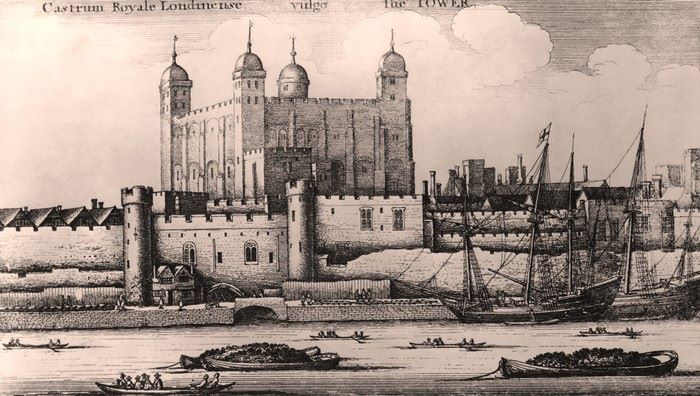The Gunpowder Plot: A Chronology

The Tower of London in the early 1600s
1532-39
Parliament, in a series of enactments, removes the Pope's power over the English Church and transfers it to King Henry VIII. Dissolution of the monasteries and other religious institutions follows.
1547-53
Edward VI reigns in England. The Church of England takes more strongly Protestant theological positions.
1553-58
Under Queen Mary I, many of the positions regarding religion taken during the reigns of her father, Henry, and her brother, Edward, are reversed. Catholicism is revived in England.
1558
Queen Elizabeth I assumes the throne and the positions taken under Henry VIII are reaffirmed. Protestant practices are reintroduced and Catholics persecuted.
1570
The Pope excommunicates Queen Elizabeth.
1585
As Spain takes steps to suppress Protestantism in the Netherlands, Elizabeth sends troops and money to defend the Protestants.
1588
Philip II of Spain sends an Armada to invade England, beginning a long European war.
1586
Mary Queen of Scots, father of King-to-be James, is implicated in a conspiracy against Elizabeth. She is tried and sentenced to death. She is executed in February 1587.
March 1603
Queen Elizabeth I dies and of King James I ascends to the throne.
May 20, 1604
Robin Catesby, Thomas Winter, John Wright, Thomas Percy and Guy Fawkes meet in the Duck and Drake in the Strand, London. Catesby proposes exploding gunpowder beneath the House of Lords on the opening of Parliament.
May 24, 1604
Thomas Percy leases a small house next to the House of Lords Chamber.
July 7, 1604
Parliament adjourns. It is scheduled to meet again on February 7, 1605.
October 1604
Plotters gather again in London. A sixth conspirator, Robert Keyes, is admitted.
December 1604
Thomas Bates becomes the seventh man to join the conspiracy.
February 7, 1605
Concerns about the Plague in London cause Parliament to be postponed
March 1605
Robert Winter, John Grant and Christopher Wright join the plot. The conspirators lease the basement storeroom under the House of Lords and begin to transfer gunpowder from Percy's house.
July 24, 1605
Father Henry Garnett, head of the Jesuit mission in England, learns about the conspiracy from Father Tesimond, who heard about it from Catesby through the confessional
July 28, 1605
Parliament is again postponed, this time until October.
Late August 1605
Fawkes and Wintour discover that the gunpowder stored under the House of Lords has decayed and will have to be replaced by fresher gunpowder.
September 29, 1605
Ambrose Rookwood joins the conspiracy
October 3, 1605
The first session of is yet again postponed, until November 5.
October 14, 1605
Francis Tresham is recruited to the plot
October 21, 1605
Sir Everard Digby becomes the thirteenth and last conspirator.
October 26, 1605
Lord Monteagle receives a mysterious letter advising him not to attend the state opening of Parliament. He takes it to the King's minister, Robert Cecil, Earl of Salisbury
October 31, 1605
After a hunting trip in Hertfordshire the King returns to London and is told about the letter the following day
November 2, 1605
Catesby and Wintour accuse Tresham, Monteagle's brother-in-law, of being an informer.
November 3, 1605
The conspirators meet and decide to continue with their plans
November 4,1605
Thomas Percy dines with his uncle, the Earl of Northumberland. Two inspections are carried out in and around the House of Lords. On the second inspection, late at night, Westminster magistrate Sir Thomas Knyvett discovers a lurking Guy Fawkes (who gives his name as John Johnson) and arrests him.
November 5, 1605
The conspirators flee London for the Midlands. Parliament meets briefly and the plot's discovery is recorded in the journal of the House of Commons
November 7, 1605
A proclamation is issued declaring the plotters to be traitors. The conspirators arrive at Holbeach House in Staffordshire. At the Tower of London, Fawkes makes the first in a series of confessions.
November 8, 1605
A local posse lays siege to the Holbeach House. Catesby, Percy and the Wright brothers are killed; the others are captured.
November 9, 1605
In a speech before Parliament, King James describes the plot and how it was thwarted. He suggests that Catholic fanatics were to blame.
December 23, 1605
Francis Tresham dies of natural causes in the Tower of London
January 15, 1606
A proclamation is issued calling for the arrest off Catholic priests implicated in the plot, including Fathers Henry Garnett and Oswald Tesimond
January 23, 1606
Parliament reassembles
January 27, 1606
Fawkes, Digby, Grant, Keyes, Rookwood, Robert and Thomas Wintour aare tried before a special commission in Westminster Hall. Henry Garnett is captured in Worcestershire
January 30, 1606
Digby, Robert Winter, Grant and Bates executed in St Paul's Churchyard
January 31,1606
Fawkes, Rookwood, Thomas Winter and Keyes executed in Old Palace Yard, Westminster
March 28, 1606
Garnett is tried at the Guildhall, London by a special commission, prosecuted by Attorney General, Sir Edward Coke. He is found guilty
May 3, 1606
Father Garnett is executed in St. Paul’s Churchyard.
